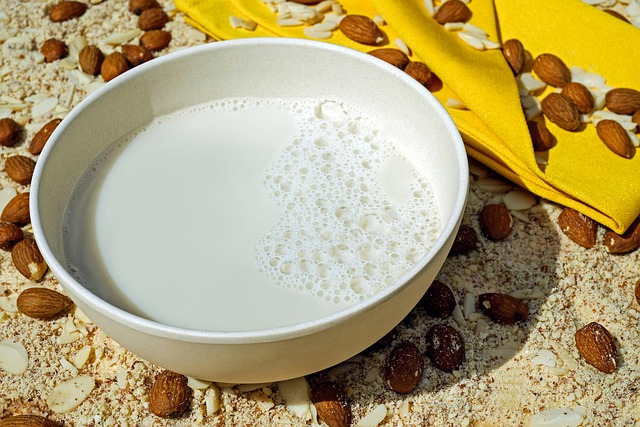
Blue Diamond Almond Milk has quickly become a staple in many households seeking a healthier, plant-based alternative to dairy. Whether you’re lactose intolerant, vegan, or simply looking for a lower-calorie option, Blue Diamond Almond Milk offers a versatile and tasty solution. In this comprehensive guide, we explore everything from its origins to its impact on health and the environment.
Blue Diamond Almond Milk
Brief History of Blue Diamond Growers

Blue Diamond Growers, the cooperative behind Blue Diamond Almond Milk, has been a pioneer in almond production since 1910. Based in California, they are one of the world’s largest almond processors. Their long-standing commitment to quality and innovation laid the foundation for their popular line of almond-based products.
Overview of Almond Milk as a Dairy Alternative
Almond milk is made by blending almonds with water and straining the mixture to remove solids. Its creamy texture and slightly nutty flavor make it a popular alternative to cow’s milk. Over the past decade, almond milk has grown in popularity due to its plant-based origin, low calorie count, and suitability for various diets.
Popularity and Growth of Almond Milk in Recent Years
Market research shows a significant rise in the consumption of plant-based milks, with almond milk leading the pack. This growth is driven by increasing health awareness, environmental concerns, and dietary restrictions.
What Makes Blue Diamond Almond Milk Unique?
Key Ingredients and Sourcing
Blue Diamond Almond Milk is crafted from California-grown almonds. These almonds are cultivated under strict quality standards, ensuring purity and freshness. The product is free from artificial flavors and is available in unsweetened and flavored varieties.
Distinctive Flavor Profile
Unlike some plant-based milks that have an overpowering taste or chalky texture, Blue Diamond Almond Milk is known for its smooth, rich, and mildly nutty flavor. This makes it suitable for drinking on its own or incorporating into a wide range of recipes.
Nutritional Benefits Compared to Other Plant-Based Milks
Blue Diamond Almond Milk generally contains fewer calories and less sugar than many other plant-based milks like soy or oat milk. It is fortified with essential nutrients such as calcium, vitamin D, and vitamin E, making it a nutritious choice.
Nutritional Breakdown
Caloric Content and Macronutrients
A one-cup serving of Blue Diamond Almond Milk contains approximately 30-60 calories depending on the variety. It offers:
- 1g of protein
- 2.5g of fat (mostly unsaturated)
- 1g of carbohydrates in the unsweetened version
Comparison with Cow’s Milk and Other Plant-Based Alternatives
Compared to cow’s milk, Blue Diamond Almond Milk has:
- Less protein but significantly fewer calories
- No cholesterol
- No saturated fat
Compared to soy and oat milk, almond milk is lower in calories and carbs but also lower in protein.
Vitamins and Minerals Present in Blue Diamond Almond Milk
Fortified varieties of Blue Diamond Almond Milk provide:
- 45% DV of calcium
- 25% DV of vitamin D
- 50% DV of vitamin E
- Small amounts of vitamin A, B12, and potassium
Health Benefits of Almond Milk

Low Calorie and Cholesterol-Free Option
Blue Diamond Almond Milk is ideal for weight management and heart health due to its low calorie and zero cholesterol content. It’s a great choice for those watching their calorie intake.
Heart Health and Antioxidants
The almonds used in Blue Diamond Almond Milk are rich in vitamin E, a powerful antioxidant that supports cardiovascular health. Additionally, unsaturated fats contribute to maintaining healthy cholesterol levels.
Lactose-Free and Suitable for Lactose-Intolerant Individuals
Since it’s made from almonds, Blue Diamond Almond Milk is naturally lactose-free, making it suitable for those with lactose intolerance or dairy allergies.
Environmental Impact of Almond Milk
Water Usage and Sustainability Considerations
One common concern about almond milk is water usage. Almond trees require substantial water, but Blue Diamond has implemented water-saving technologies and practices to reduce environmental impact.
Comparison with Dairy Milk Regarding Carbon Footprint
Despite water concerns, Blue Diamond Almond Milk has a significantly lower carbon footprint compared to dairy milk. The production of almond milk generates fewer greenhouse gases and requires less land.
Blue Diamond’s Commitment to Sustainable Farming Practices
Blue Diamond Growers have invested in sustainable farming techniques, including:
- Drip irrigation systems to conserve water
- Soil health improvement practices
- Bee-friendly farming initiatives
Ways to Incorporate Blue Diamond Almond Milk into Your Diet
Recipes for Smoothies and Shakes
Blue Diamond Almond Milk blends seamlessly into smoothies. Try it with bananas, spinach, and protein powder for a nutritious breakfast or post-workout shake.
Use in Baking and Cooking
This almond milk can be used in place of dairy milk in most baking recipes. It works well in pancakes, muffins, soups, and sauces without altering taste.
Alternatives for Coffee and Tea (e.g., Almond Milk Lattes)
Froth up Blue Diamond Almond Milk for a creamy addition to coffee. It creates a delicious almond milk latte that rivals café options.
Flavor Varieties and Products
Overview of Available Flavor Options
Blue Diamond offers a wide range of almond milk flavors, including:
- Original
- Unsweetened Original
- Vanilla
- Unsweetened Vanilla
- Chocolate
Each option provides unique taste experiences tailored to different preferences and dietary needs.
Introduction to Other Blue Diamond Products
Beyond almond milk, Blue Diamond also produces:
- Almond-based creamers
- Almond flour
- Nut-based snacks
- Almond protein powder
Recommendations Based on Taste Preferences
- For a sweet treat: Try Chocolate or Vanilla
- For a cooking base: Use Unsweetened Original
- For coffee: Barista Blend or Unsweetened Vanilla
Possible Drawbacks and Considerations
Allergies and Sensitivities to Nuts
Individuals with tree nut allergies should avoid Blue Diamond Almond Milk. Always check with a healthcare provider before trying new foods.
Added Sugars and Additives in Flavored Varieties
Flavored versions like Chocolate and Vanilla may contain added sugars. Check labels for sugar content and opt for unsweetened versions when possible.
Cost Comparison with Traditional Milk and Other Alternatives
Almond milk can be more expensive than cow’s milk and some other plant-based milks. However, the nutritional and environmental benefits may justify the cost for many consumers.
Consumer Reviews and Popular Opinions
Summary of Reviews from Various Platforms
Reviews across online retailers and health blogs are generally favorable. Consumers appreciate the taste, versatility, and health benefits of Blue Diamond Almond Milk.
Common Praise Points and Criticisms
Praise:
- Delicious taste
- Long shelf life
- Easy to digest
Criticisms:
- Some varieties are too sweet
- Price point is higher
- Low protein content compared to soy milk
Discussion of the Brand’s Reputation in the Market
Blue Diamond is recognized for quality and innovation in the plant-based milk space. Their transparent sourcing and sustainability efforts bolster consumer trust.
Conclusion and Final Thoughts
Recap of the Benefits and Versatility of Blue Diamond Almond Milk
From its rich, creamy taste to its health and environmental advantages, Blue Diamond Almond Milk is a standout choice among plant-based milks. Its wide range of flavors and uses make it suitable for nearly every dietary need and preference.
Encouragement for Readers to Try and Experiment with Almond Milk
If you’re new to almond milk, start by incorporating it into your coffee or cereal. Explore different flavors and recipes to find your favorites.
Call-to-Action for Feedback and Sharing Experiences in the Comments Section
Have you tried Blue Diamond Almond Milk? Share your experience in the comments below! Whether you have a favorite recipe or flavor, we’d love to hear how almond milk fits into your lifestyle.
